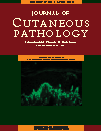Fibrillar IgA deposition in dermatitis herpetiformis – an underreported pattern with potential clinical significance
Abstract
Dermatitis herpetiformis has characteristic clinical and histopathologic findings. A fibrillar pattern of IgA deposition on direct immunofluorescence in dermatitis herpetiformis is underreported. Here, we describe three patients with the fibrillar pattern of IgA deposition on direct immunofluorescence examination that initially misled diagnosis in one of the three. Interestingly, two of the three patients lacked anti-transglutaminase and anti-endomysial antibodies but had a clinical course typical of dermatitis herpetiformis. Dermatitis herpetiformis may have a fibrillar rather than granular pattern of IgA deposition on direct immunofluorescent microscopy, and patients with this pattern of immunoglobulin deposition may lack circulating autoantibodies.
Ko CJ, Colegio OR, Moss JE, McNiff JM. Fibrillar IgA deposition in dermatitis herpetiformis—an underreported pattern with potential clinical significance.




